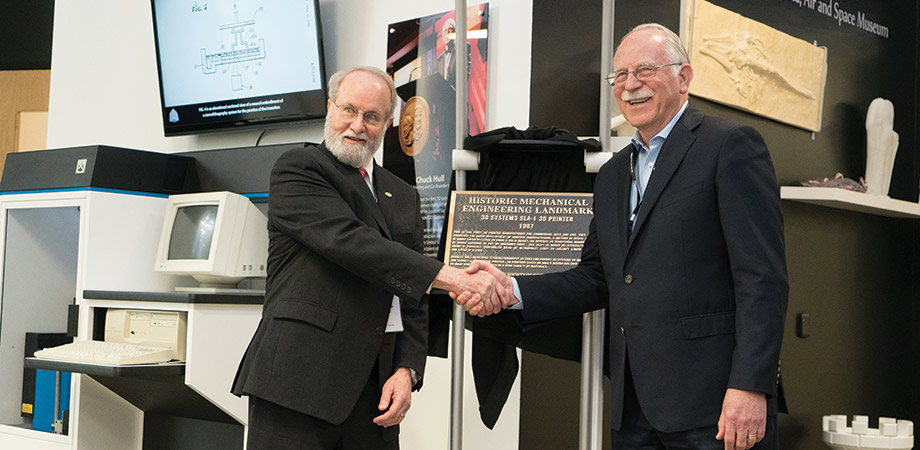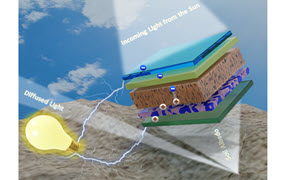3D Printing: Chuck Hull and a whole new way of making things

Chuck Hull initially saw his invention of 3D printing as having a niche application—a better way to make prototypes of plastic parts for engineers to test. In the 40 years since his idea dawned, the 3D-printing industry, also called additive manufacturing or stereolithography, has grown to around $20 billion, with prototyping as one of the largest markets. To honor his achievement, in October 2023, US President Joe Biden presented Hull with the US National Medal of Technology and Innovation.
What launched Hull on his path to invention was his desire to stay in California, where he had lived since 1961 after earning an engineering degree. Rather than move to Delaware in 1979, as his then-employer DuPont had asked, he left the chemicals giant for a small San Gabriel, California, company making ultraviolet (UV) lamps and related products. One application of an Ultra Violet Products’ (UVP) UV lamp was to cure liquid photopolymers, turning them into sturdy solid-plastic coatings.
The process of curing photopolymers with UV radiation was new to Hull, and it gave him an idea. “I knew that prototyping plastic parts was always a hassle for engineers that took weeks or months from when they had a design to when they had the first sample,” he says. He saw that frustration firsthand when prototyping a plastic part for a UVP lamp he had designed. Observing the UV curing process, he realized “maybe we could use this to make or print plastic parts.”
His boss wouldn’t let Hull use company time to try out his idea, but he did let Hull work evenings and weekends in a company lab. After months of testing materials, light sources, and optics, Hull called his wife one evening in 1983 and said, “You gotta come down to the lab.” It was late, and she made it clear, “this better be good,” Hull remembers. When she arrived at the lab, “I handed her the very first part and she still has it,” he says with a laugh.
That first machine focused UV light from a UVP short-arc mercury lamp onto a small spot on the liquid plastic. It included a control system, an x-y scanner to move the spot, and an elevator to move the part vertically in a vat of liquid polymer to create more layers. But it only formed one spot at a time, so automation, too, was needed. When the setup was complete, he worked with a patent lawyer to write and file a patent. In 1986, Hull went back to the UVP president to outline his plan for building a business of making machines to produce prototype plastic parts.
Hull could see a clear path to selling 3D printers for plastic prototypes, but the president wasn’t willing to invest the money Hull thought necessary. Instead, he let Hull spin out his own company, licensing the technology. Raising the money was a tough job, but Hull found a Canadian venture capital firm willing to put up the money for what would become 3D Systems, a public company.
Their first commercial 3D printer was ready in 1987 and sold in 1988. It used lasers because the beams produced smaller focal spots and could be scanned to cure the plastic much faster than UV lamps. Materials remained a problem until the company teamed with Ciba Geigy in Switzerland to develop new plastics for 3D printing. By then startups and some larger companies began emerging as competition, but Hull was a trail-blazing luminary widely regarded as the inventor of 3D printing.

3D Systems’ SLA-1 was the first commercial 3D printer. Photo Courtesy of 3D Systems
The most intense interest in the emerging technology came from Detroit. US automakers were facing tough competition from Japanese companies who could deliver new models to the showroom faster. Detroit had adopted 3D computer-aided design (CAD) but was bogged down by prototyping. Hull got “a lot of interest from all the Detroit automakers” in 3D printing, but at first the CAD companies showed no interest.
That changed quickly once a big automaker said it was working on two betas with 3D Systems. Feeding CAD input into the scanners was a big step forward, says Hull. “We developed what’s still called the STL [stereolithography] format” that is still used to convert CAD output into printable form. At the time, CAD was done on workstations, but the first IBM PC came on the market at about the same time. Those early PCs were slow and not well suited for CAD, but as computer technology advanced, workstations and PCs could handle more powerful CAD and the STL format matched CAD to 3D printing.
“Our first big customers were automotive,” says Hull. Their first uses of 3D printing were prototyping parts installed under the dashboard, many of which were plastic. Then they expanded to prototyping plastic components under the hood. Soon it spread to aerospace, healthcare, and other industries “to the point where we were involved in prototyping almost anything that was made out of plastic.” That, in turn, required developing plastics able to meet new requirements such as very precise shapes and dimensions. Once printable plastics were able to withstand the mechanical and environmental requirements for use in a car, 3D printing could mass-produce plastic parts for manufacturing runs and spare parts, earning the name, additive manufacturing.
Fabrication of metal components posed different challenges, so 3D Systems devised a variation on the lost-wax casting process. It started with 3D printing of a meltable plastic master rather than sculpting a wax master that would be encased in ceramic. Once the ceramic hardened, the plastic master would be melted out and the ceramic would serve as a mold into which molten metal was poured, as in lost-wax casting. This process is still widely used in aerospace.
Additive manufacturing based on melting powdered metals grew from work at the Fraunhofer Institute in Germany in the 1990s. Initially, it required a mixture of metal powders, one of which had a low melting temperature, but in 2004 the Electro Optical Systems Group of Germany demonstrated high-temperature printing of dense metals by melting powders with a 200-watt diode-pumped fiber laser. Advances in high-power fiber lasers have advanced that technology greatly.
3D printing also became a foundation stone of the maker culture around the turn of the century. Hobbyists intrigued by the idea realized they could build small and affordable 3D printers. Some built their own from scratch and some sold blueprints. “That spread out to become what’s called the maker movement,” says Hull. Now you can buy cheap ones on the internet. “As a hobbyist, you can make a lot of really interesting stuff.”
Hull retired once, but he got tired of that and when the CEO of 3D Systems asked him to come back as chief technology officer, he says, “It took me about three seconds to say yes.” He’s fascinated to be working on new ideas in medicine, like printing scaffolds for growing transplantable kidneys or livers, and talks excitedly about working with United Therapeutics on producing transplantable human lungs. “It’s all been pretty amazing.”
Jeff Hecht is an SPIE Member and freelancer who writes about science and technology.



